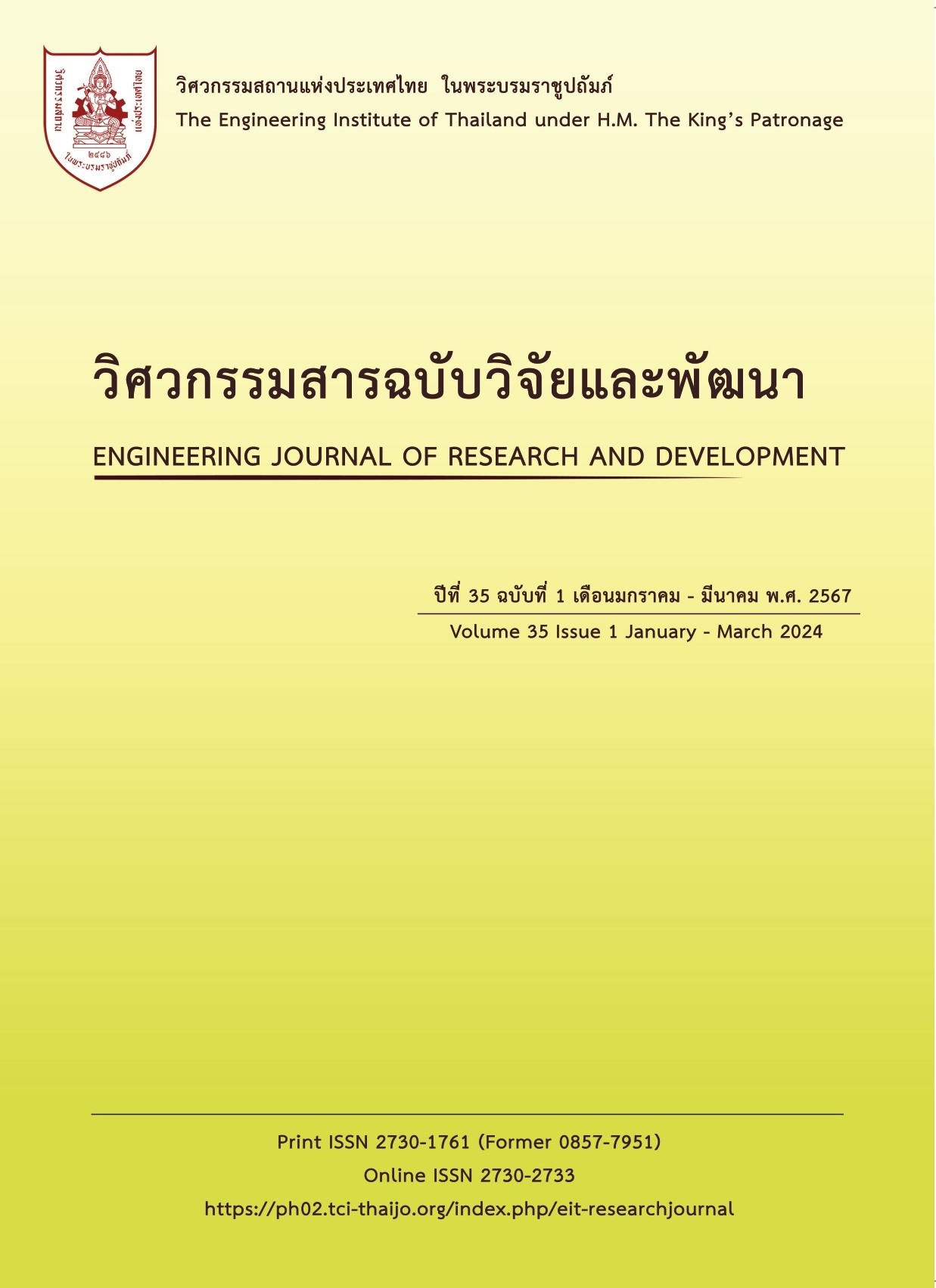SATELLITE DERIVED BATHYMETRY PRODUCTION CASE STUDY AT DEEPWATER PORT OF MAPTAPHUT INDUSTRIAL PARK RAYONG
Main Article Content
Abstract
The satellite-derived bathymetry model (SDB) is an alternative way of making elevation data for large nearshore areas. This is essential for geological study, coastal environment, and transportation management in deepwater ports because the nearshore depth around the port should be deeper than on a typical beach. This study is about finding the bathymetry production method using Sentinel-2 imagery and depth data from a bathymetry boat at Maptaphut Industrial Area Deepwater Port, Rayong. The suitable images were downloaded over a three-month period. This study investigated the model production from Lyzenga and Stumpf's empirical formulas and blue band selection (bands 1 and 2 from the sentinel-2 image) for better model accuracy. The results showed that model accuracy is about 2–5 m, Lyzenga algorithm was probably same with Stumpf algorithm and the blue band in band 2 was better than band 1. The main limitation of model production in this study was that a lot of turbidity covered the water surface, so the depth estimation model was shallower than field depth data, resulting in lower accuracy in these areas
Article Details

This work is licensed under a Creative Commons Attribution-NonCommercial-NoDerivatives 4.0 International License.
The published articles are copyright of the Engineering Journal of Research and Development, The Engineering Institute of Thailand Under H.M. The King's Patronage (EIT).
References
Kiyoshi Horikawa et. al. Nearshore Dynamics and Coastal Processes: Theory, Measurement, And Predictive Models, Tokyo: University of Tokyo Press, 1988.
Parrish, C.E. Magruder, L.A. Neuenschwander, A.L. Forfinski-Sarkozi, N. Alonzo, M. Jasinski, M. Validation of ICESAT-2 ATLAS Bathymetry and Analysis of ATLAS’s Bathymetric Mapping Performance. Remote Sensing, 2019, 11 (14). Available from: https://doi.org/10.3390/rs11141634 [Accessed 14 February 2023].
Gottfried Mandlburger. A Review of Active and Passive Optical Methods in Hydrography, 2022. Available from: https://ihr.iho.int/articles/a-review-of-active-and-passive-optical-methods-in-hydrography/ [Accessed 14 February 2023].
Chiang, J.Y., Chen, YC., Chen, YF. Underwater Image Enhancement: Using Wavelength Compensation and Image Dehazing (WCID), 2011. Available from https://doi.org/10.1007/978-3-642-23687-7_34 [Accessed 14 February 2023].
Duplanˇci´c Leder, T. Bauˇci´c, M. Leder, N. and Gili´c, F. Optical Satellite-derived Bathymetry: An Overview and WoS and Scopus Bibliometric Analysis. Remote Sensing, 2023, 15(5):1294. Available from: https://doi.org/10.3390/rs15051294 [Accessed 14 February 2023].
ชนัตถพงศ์ เสืองามเอี่ยม และ ศิริวิไล ธีระโรจนารัตน์. การหยั่งความลึกน้ำทะเลจากการรับรู้ะยะไกลในอ่าวไทยด้วยภาพถ่ายดาวเทียมแลนด์แซท 8. วารสารวิชาการโรงเรียนนายเรือ ด้านวิทยาศาสตร์และเทคโนโลยี ปีที่ 5 ฉบับที่ 1, 2565.
Ashphaq, M. Srivastava, P.K. and Mitra, D. Review of Near-shore Satellite Derived Bathymetry: Classification and Account of Five Decades of Coastal Bathymetry Research. Journal of Ocean Engineering and Science, 2021, 6 (4), pp. 340-359
Meliala, L. Wibowo, W A and Amalia, J. Satellite Derived Bathymetry on Shallow Reef Platform: A Preliminary Result From Semak Daun, Seribu Islands, Java Sea, Indonesia. The 1st International Conference on Geodesy, Geomatics, and Land Administration, 2019, pp 192-202. DOI: 10.18502/keg.v4i3.5849
Najhan Md Said, Mohd Razali Mahmud and Rozaimi Che Hasan. Satellite-derived Bathymetry: Accuracy Assessment on Depths Derivation Algorithm for Shallow Water Area. The International Archives of the Photogrammetry Remote Sensing and Spatial Information Sciences, 2017.
Gasica, T. A. and Pratomo, D. G. Shallow Waters Depth Estimation Using Empirical Satellite Derived Bathymetry and Sentinel-2 Data, Case Study: East Coastal Waters of Java Island. The International Archives of the Photogrammetry Remote Sensing and Spatial Information Sciences, 2022, pp. 93–99. DOI: 10.5194/isprs-archives-XLIII-B3-2022-93-2022
Lyzenga, D. R. Passive Remote Sensing Techniques for Mapping Water Depth and Bottom Features. Applied Optics, 1978, 17(3), 379–383
Geyman, E.C. and Maloof, A.C. A Simple Method for Extracting Water Depth From Multi Spectral Satellite Imagery in Regions of Variable Bottom Type. Earth and Space Science, 2019, 6, pp. 527–537. https://doi.org/10.1029/2018EA000539
Stumpf, R.P. Holderied, K. and Sinclair, M. Determination of water depth with high-resolution satellite imagery over variable bottom types. Limnology and Oceanography, 2003, 48(1), pp. 547–556.
Google Developers. Sentinel-2 MSI: MultiSpectral Instrument, Level-2A, 2022. Available from: https://developers.google.com/earth- engine/datasets/catalog/COPERNICUS_S2_SR [Accessed 1 July 2022].
Li, J. Knapp, D.E. Lyons, M. Roelfsema, C. Phinn, S. Schill, S.R. Asner, G.P. Automated Global Shallow Water Bathymetry Mapping Using Google Earth Engine. Remote Sensing, 2021, https://doi.org/10.3390/rs13081469
Vanhellemont, Q. Daily Metre-scale Mapping of Water Turbidity Using Cubesat Imagery. Optics Express, 2019, 27.
Lee, Z. Weidemann, A. Arnone, R. Combined Effect of Reduced Band Number and Increased Bandwidth on Shallow Water Remote Sensing: the Case of Worldview 2. IEEE Transactions on Geoscience and Remote Sensing. 2013, 51 (5), pp. 2577–2586.
Xu, H. Modification of Normalized Difference Water Index (NDWI) to Enhance Open Water Features in Remotely Sensed Imagery. International Journal of Remote Sensing, 2006, 27(14), pp. 3025–3033.

